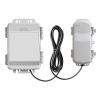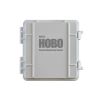HOBOnet Wireless T12 Soil Moisture/Temp/EC Sensor
Features
- 900 MHz wireless mesh self-healing technology
- 450 to 600 meter (1,500 to 2,000 feet) wireless range and up to five hops
- Up to 50 wireless sensors or 336 data channels per HOBO RX station
- Free ground shipping
- Expedited repair and warranty service
- Lifetime technical support
- More
Overview
The HOBOnet T12 is a wireless sensor that works with the HOBOnet system to provide advanced soil moisture (volumetric water content), temperature, and electrical conductivity measurements.
Design
Designed to withstand harsh environmental conditions, these durable sensors last up to 10 years, so you can leave them in the field for extended periods of time. Sharpened stainless-steel probe tips make installation easy, even in hard soil, and a large volume of influence provides more accurate results. The HOBOnet T12 is backed by over 20 years of soil-moisture research and features a trademark 70MHz frequency capacitance technology, minimizing salinity and textural effects.
Applications
The HOBOnet system is a cost-effective and scalable wireless sensor network for web-enabled monitoring of field conditions for applications such as crop management, research, and greenhouse operations. And because it's wireless, users can deploy a network of sensors to easily monitor multiple points with a single system, while avoiding the risk of long cables that can interfere with field operations and are potentially vulnerable to nearby lightning strikes. Sensors are easily linked to the network, and data can be accessed through HOBOlink, Onset's innovative cloud-based software platform.
Verification Clip
The optional Verification Clip provides a convenient way to confirm the operation and soil moisture accuracy of HOBOnet T11 and T12 sensors. Attaching this clip to a sensor provides a known soil moisture level for verifying measurement accuracy, without having to test the sensor in actual soils, which normally requires weighing soil samples and drying them in an oven.
In The News
Wildfire Prevention in the Sierra Nevada Region with the Yuba Watershed Institute
Though recent wildfires have sparked new conversations about wildfire management and response, groups like the Yuba Watershed Institute have been monitoring the forests and water resources of the Sierra Nevada region for decades, managing approximately 5,000 acres of land with the Bureau of Land Management (BLM) and about 7,000 acres in private land partnerships. The goal of the Institute is to work with local communities and land agencies to improve watershed and forestry management through informed practices and public outreach. The goals of the Yuba Watershed Institute are three-fold: Improve the ability of fire suppression agencies like the California Department of Forestry and Fire Protection ( CAL FIRE ) and the US Forest Service.
Read MoreWave Sensors Integration with NexSens Buoys: A Cutting-Edge Solution for Wave Measurment
Real-time wave data supports accurate weather prediction, safe and efficient maritime operations, and provides valuable safety and operating condition information for recreation and commercial fishing. Understanding wave dynamics also helps with the design of protective coastal structures like seawalls, breakwaters, and jetties. It also supports better prediction of their impact on sediment transport and coastal geomorphology. Wave data is a key factor in qualifying and designing offshore wind farms and harnessing kinetic energy for electrical generation. It helps with the understanding of ocean-atmosphere interactions and contributes to studies of sea-level rise and climate change impacts.
Read MoreSpring 2025 Environmental Monitor Available Now
In the Spring 2025 edition of the Environmental Monitor, we highlight partnerships across the world and the importance of collaboration between government agencies, universities, environmental groups, local communities, and other stakeholders. From great white shark research in Cape Cod to monitoring fisheries in Lake Erie, this latest edition underscores partnerships that connect stakeholders in a watershed through environmental data. With an emphasis on data sharing, a combination of real-time and discrete sampling keeps the public and partners informed of environmental conditions. Our writers also sought out science professionals dedicated to working with peers within and outside of the environmental sector.
Read More














